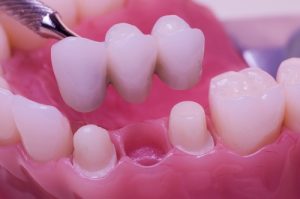 Bridges can solve the issue of missing teeth. Similar to dentures, bridges replace gaps in your smile with artificial teeth. Bridges can be made from a variety of materials including porcelain, gold, and alloys.
Bridges can solve the issue of missing teeth. Similar to dentures, bridges replace gaps in your smile with artificial teeth. Bridges can be made from a variety of materials including porcelain, gold, and alloys.
Bridges can be removable or fixed. Removable bridges can be taken out and cleaned by patients, whereas fixed bridges have to be removed by a dentist. Bridges can be implanted to the jaw or under the gums. With so many options, it is important to consult with your dentist about which type of bridge is best for you.
You should always keep your current teeth healthy and strong, but a bridge can help if you do lose teeth. Contact us today to discuss which bridge might be right for you.
An extraction is performed to remove a tooth, whether because of disease, crowding, or damage. When extractions are required, the area around the tooth will be numbed and your dentist will remove the tooth. A small amount of bleeding is normal, as your mouth will replace the removed tooth root by forming a blood clot in the area.
Caring for your mouth after an extraction is very important. Your dentist will outline how you should care for the area of the extraction. It is important to allow your mouth time to heal, so avoid activities like smoking, drinking through a straw, or eating foods that may aggravate the area.
If you experience any complications, like excessive swelling, be sure to call your dentist right away. Your dentist may also recommend pain medication when appropriate. While you can care for your other teeth as normal, be careful not to clean the teeth next to the extraction.
If you are experience pain or discomfort, visit our office today so we can determine if you need an extraction. Delaying a consultation can worsen the situation and require longer recovery times.

